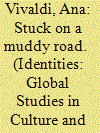| Srl | Item |
| 1 |
ID:
098351


|
|
|
|
|
| Publication |
2010.
|
| Summary/Abstract |
This study examined the correlates of distance to crime in a sample of 412 prison inmates in the Mexico City Metropolitan Area. The study focused on crimes of theft and included a spatial analysis of the crime scene and the place of residence of the prison inmates. The data show a high clustering of criminals in a few neighbourhoods surrounding the old downtown area. Also, 38.8% of the sampled criminals committed their crimes in the same neighbourhood where they lived. Regression analysis revealed two independent and positive correlations of distance to crime: the monetary gain of the crime and if the prison inmates' intimate partner was also in jail. These findings suggest that, aside from the monetary rationale in the distance to crime function, the neighbourhood and family contexts deserve further research for a better understanding of criminal behaviour in Mexico.
|
|
|
|
|
|
|
|
|
|
|
|
|
|
|
|
| 2 |
ID:
147828


|
|
|
|
|
| Summary/Abstract |
�is article studies the relationship between social and spatial mobility
of new urban migrants and residents. �e objective is to present the
in�uences of the household registration system on the social mobility of
China’s new urban migrants through a comparison of the di�erences
and similarities between these two groups. Two data sets are adopted in
this article: the Blue Book of Youth Nos. 1 and 2 and in-depth interviews
conducted during the summers of 2009, 2010, and 2011.
�ematic analysis was employed to understand their social mobility
a�er spatial mobility. Results show that new urban migrants are relatively
vulnerable. While society generally expects them to assimilate
rather than achieve upward social mobility, the hukou system limits
their access to social welfare and security. Meanwhile, new urban residents
who have access to advantages consider themselves lower-middle
class in terms of consumption, and maintain certain flexibility to
further establish their social and economic status. In this article,
“opportunity” is a significant theme. New urban residents strive to
leverage their urban resident status to create individual wealth.
|
|
|
|
|
|
|
|
|
|
|
|
|
|
|
|
| 3 |
ID:
113899


|
|
|
|
|
| Publication |
2011.
|
| Summary/Abstract |
This article explores how the Toba, an indigenous group in the North of Argentina, shape places and an urban subjectivity in the frictions of their mobility between villages, the urban barrio (neighborhood), and the periurban bush. I argue that the experience of Toba moving to the city is better understood as frictions between the Toba desire to progress in the city, the organization of difference in space, and their multiple movements "back" to the villages. In addition, I analyze their contemporary hunting trips, which take urban Toba to the nearby bush, as a mobility that shapes a form of indigeneity engaged with access to both the city center and the bush. This practice confronts them with ranch owners and police but reconnects the barrio and the bush by traversing them. If frictions emerge between forces that trigger movement and forces that slow that movement down, in the frictions of mobility the Toba have at once shaped their position in the city and overflowed its limits.
|
|
|
|
|
|
|
|
|
|
|
|
|
|
|
|